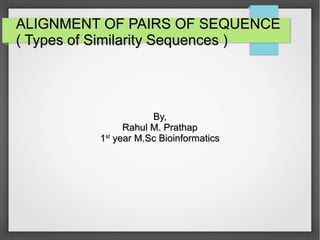
Alignment of pairs of sequence (Types of Similarity Sequences)
- 1. ALIGNMENT OF PAIRS OF SEQUENCEALIGNMENT OF PAIRS OF SEQUENCE ( Types of Similarity Sequences )( Types of Similarity Sequences ) By,By, Rahul M. PrathapRahul M. Prathap 11stst year M.Sc Bioinformaticsyear M.Sc Bioinformatics
- 2. What’s in this presentation ? What is Sequence alignment ? Types of Similarity Sequences Homology Orthology Paralogy Analogy Xenelogy
- 4. What is Sequence alignment ? It is a way of arranging the sequences of DNA, RNA, or protein to identify regions of similarity. It may be a consequence of functional, structural, or evolutionary relationships between the sequences. Eg:- GOPGOPI VARUNVARUN_ _ - ( Red : Mismatch )- ( Red : Mismatch ) GOPGOPY VARUNANVARUNAN - ( Green : Gaps )- ( Green : Gaps )
- 5. Aligned sequences of nucleotide or amino acid residues are typically represented as rows within a matrix. An alignment between two sequences is simply a pairwise match between the characters of each sequence. A true alignment of nucleotide or amino acid sequences is one of that reflects the evolutionary relationship between two or more homologs (sequences that share a common ancestor). If characters are similar due to convergent evolution we call it as Analogs.
- 6. Homology Homologous genes are genes that derive from a common ancestor. Homologous genes can arise through a variety of different biological processes. Speciation Gene duplication
- 7. Pairs of homologous genes derived by speciation which results in two homologous genes diverging in different lineages are described as Orthologous and called Orthologs. Homologous genes which arise by gene duplication, the process by which a gene becomes copied, within the same genome are described as paralogous, and are called paralogs, which can be more formally defined as a pair of genes whose most recent common ancestor occurred immediately before a gene duplication event.
- 8. Orthology Sequences which are inferred to be descended from the same ancestral sequence separated by a speciation event: when a species diverges into two separate species. Speciation — is the phenomenon during which a common ancestor gives birth to two subgroups that slowly drift away from their common genetic makeup to become distinct species.
- 9. The term "ortholog" was coined in 1970 by the molecular evolutionist Walter Fitch.
- 10. These genes in different species originated by vertical descent from a single gene of the last common ancestor. Biologists usually expect orthologs to have similar functions and structure.
- 11. In the figure below, A1 and A2 are orthologs, and so are B1 and B2.
- 12. Let’s see some examples....
- 13. Arabidopsis thaliana (Thale Cress) Chlamydomonas (Green algae) The plant Flu regulatory protein is present both in Arabidopsis (multicellular higher plant) and Chlamydomonas (single cell green algae). The Chlamydomonas version is more complex: it crosses the membrane twice rather than once, contains additional domains and undergoes alternative splicing. However it can fully substitute the much simpler Arabidopsis protein, if transferred from algae to plant genome by means of genetic engineering. Significant sequence similarity and shared functional domains indicate that these two genes are orthologous genes, inherited from the shared ancestor.
- 14. Paralogy Paralogs are homologues separated by a duplication event, meaning that within a genome, a gene was duplicated. One of the duplicates may have kept the original function while the other duplicate could have acquired a new function. Mechanism of gene duplication allows these sequences to evolve different functions.
- 15. A1 and B1 are paralogs in the figure shown below.
- 16. The hemoglobin gene of humans and the myoglobin gene of chimpanzees are Paralogs. The four known classes of hemoglobins (hemoglobin A, hemoglobin A2, hemoglobin B, and hemoglobin F) are paralogs of each other. While each of these proteins serves the same basic function of oxygen transport, they have already diverged slightly in function: fetal hemoglobin (hemoglobin F) has a higher affinity for oxygen than adult hemoglobin.
- 17. Analogy If similarity between sequences arises due to convergent evolution, those genes are called Analogs. Convergent evolution creates analogous sequences that have similar form or function but were not present in the last common ancestor of those groups.
- 18. In 2013 the first genome-wide study of convergence was published. Comparisons of the genomes of echolocating bats and the dolphin identified numerous convergent amino acid substitutions in genes implicated in hearing and vision.
- 19. Xenelogy Homologs resulting from horizontal gene transfer between two organisms are termed xenologs. Xeno is a Greek word that means “foreigner”. It is also coined by Walter Fitch. Xenologs result from a lateral transfer between two organisms — a direct DNA transfer between two species. Xenologs can have different functions, if the new environment is vastly different for the horizontally moving gene.
- 20. A typical case of lateral transfer (or xenologs) is the acquisition of the isoleucyl- tRNA synthase from their host by several bacteria. The isoleucyl-tRNA synthase is a protein involved in the synthesis of other proteins, and its acquisition by bacteria seems to help them becoming antibiotic resistant. When this happens, the newly acquired isoleucyl-tRNA synthase is a xenolog of the other tRNA synthases contained in the bacteria.
- 21. Thank You !!!!Thank You !!!!